This is the earliest known photograph of Jimmy, described in The Bugle‘ of 27 October 1899, as ‘taken with the Sergts [Sergeants], at Kasr-el Nil Barracks, Cairo’
in 1886. Although ‘The Bugle’ describes him as a ‘little dot of 3’, he was, in fact, less than two years old. He is shown in a khaki drill uniform, with sergeant’s stripes and red sash and the Egypt Medal and Khedive’s Star. The Bugle proudly relates how ‘even at the early age of 3 [Jimmy] has quite a martial air.’




‘Our little Soudan Trophy… squatted between Sergeant Major Francies’ legs, and…supported on the right hand by Colour Sergeant Smith of F. Company and on the left by the late Colour Sergeant of E Coy.’
On the same page, there is mention that a photograph of ‘Bugler Durham’
had recently been sent out to ‘several old friends’
, including Sergeant Major Francies, all of whom ‘notice a great change in “Jimmy” since they were serving with us’
. This photograph must have been taken around the time of his enlistment into the Regiment in July 1899.
See a transcript of The Bugle, 27 October 1899, p.3045.
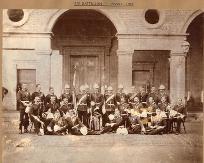

In this photograph, taken at the Ghorpuri Barracks in Poona, India, in 1887, Jimmy is pictured with an officer and colour party of the 2nd Battalion The Durham Light Infantry. He is wearing a khaki uniform and sergeant’s sash, and an Egypt Medal.
Immediately behind him is Sergeant Stuart, who is touching his head in an apparently affectionate manner, though it may have been to keep him still for the photograph.
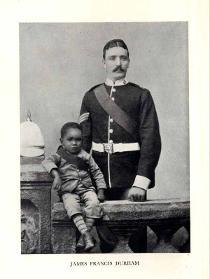

Here, James Francis Durham is pictured with Sergeant Stuart, when he is about two or three years old. He wears a sergeant’s stripes and sash, just like Stuart.


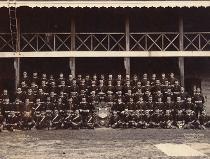

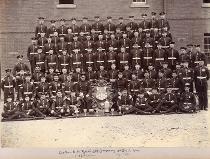

![Photograph of band [1900-1910] (D/DLI 7/194/10) - Copyright © Durham County Record Office. Photograph of band [1900-1910] (D/DLI 7/194/10) - Copyright © Durham County Record Office.](https://durhamrecordoffice.org.uk/wp-content/uploads/2022/06/d_dli0007_0194_0010_large.jpg)

The battalion moved to England in December 1902 and remained there until October 1905, when it travelled to Ireland. Jimmy is part of Captain R.M. Tyler’s H Company and is aged about 19. Again, the Company is pictured with the Best Shooting Companies Shield.
In another photograph taken at the Corunna Barracks, Aldershot, in 1904, Jimmy is pictured with the rest of the Band.
![Photograph of James Durham with sheep [1900-1910] (D/DLI 7/194/8) - Copyright © Durham County Record Office. Photograph of James Durham with sheep [1900-1910] (D/DLI 7/194/8) - Copyright © Durham County Record Office.](https://durhamrecordoffice.org.uk/wp-content/uploads/2022/06/d_dli0007_0194_0008_large_1.jpg)

Here, Jimmy is pictured at Aldershot in 1904 with the regimental mascot, a sheep, ‘Robert Canning’, or Billy as he was generally known.
The sheep was acquired on board the Royal Indian Marine Ship ‘Canning’ when the 2nd Battalion was travelling from Mandalay, Burma, to Wellington, India in December 1900.
Billy was given as a prize, by the officers, for sports on board ship, and was destined for their Christmas dinner. However, E Company, on winning the sheep, decided to keep him as a pet, assigned him the number 9999 and called him ‘Robert Canning’.
He travelled to Aldershot with them in 1902, where he was free to roam where he pleased in the barracks.
![Photograph of James Durham[1900-1910] (D/DLI 7/194/9) - Copyright © Durham County Record Office. Photograph of James Durham[1900-1910] (D/DLI 7/194/9) - Copyright © Durham County Record Office.](https://durhamrecordoffice.org.uk/wp-content/uploads/2022/06/d_dli0007_0194_0009_large.jpg)

A photograph, signed ‘Yours sincerely James Durham’, taken by a Cork photographer when the 2nd Battalion was in Ireland. The Battalion was stationed at the Victoria Barracks, Cork, from October 1905 until January 1909, so Jimmy is in his early 20s.
Jimmy is wearing his best (full dress) uniform of red tunic (jacket) with dark green facings (collar and cuffs) and brass buttons. His trousers are dark blue, with a thin red stripe down the outside of each leg, and with a white leather waist belt with brass clasp. His boots are black leather.
On his tunic, you can see red and white striped bandsman’s wings on each shoulder; his bandsman’s badge on his right arm; two long service stripes above his left cuff; and two DLI bugle badges on his collar. His cap on the chair has a leather peak and DLI badge, and he is carrying a walking-out cane. Standing Orders for 2DLI in 1907 state that ‘A soldier is never to appear outside the barracks on any excuse without being properly dressed … He must be clean and well shaved, and carry a cane of the regimental pattern’
. These canes made the soldiers look smart and stopped them from putting their hands in their pockets!
![Photograph of James Durham with sheep [1900-1910] (D/DLI 7/194/8) - Copyright © Durham County Record Office. Photograph of James Durham with sheep [1900-1910] (D/DLI 7/194/8) - Copyright © Durham County Record Office.](https://durhamrecordoffice.org.uk/wp-content/uploads/2022/06/civilian_clothes_large.jpg)

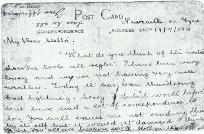

‘What do you think of the masta, does he look all right’?He is planning to visit her and ‘their’ father, remarking,
‘Roll on the 29th’.
See a transcript of the postcard dated 17 July 1908.
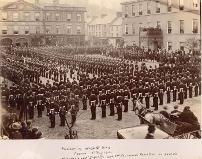

While the Battalion was in Fermoy, Ireland, George V became King, on 6 May 1910.
A parade was held to mark the occasion, by the 2nd Battalion The Durham Light Infantry and the 2nd Sherwood Foresters. The band can be seen in the centre of the square; no doubt Jimmy was among them.
This is a photograph of Jimmy’s funeral in Fermoy, Ireland, in August 1910 after he died of pneumonia. He was buried with full military honours in the local cemetery.
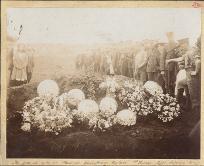

The floral tributes and the large gathering of mourners bear witness to his popularity as recorded in the ‘Digest of Services’ [D/DLI 2/2/15]. In fact, some of the old sergeants, who had been with him in Egypt 25 years earlier, travelled from County Durham to be present at the service.
The inscription on his grave read ‘In loving memory of Bandsman James Francis Durham, 2nd Bn., the Durham Light Infantry who died on August 8, 1910. Erected by the Officers, NCOs and men of the Battalion. Jimmy Durham was adopted by the Battalion after the Battle of Ginnis 1885 and specially enlisted in the Durham Light Infantry, May 23, 1899′.


